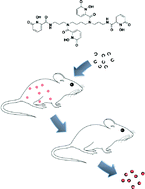3,4,3-LI(1,2-HOPO): In vitro formation of highly stable lanthanide complexes translates into efficacious in vivoeuropium decorporation†
Abstract
The spermine-based hydroxypyridonate octadentate

* Corresponding authors
a
Chemical Sciences Division, Lawrence Berkeley National Laboratory, Berkeley, CA, USA
E-mail:
rjabergel@lbl.gov
Fax: +1 510 486 5596
Tel: +1 510 486 5249
b Department of Chemistry, University of California, Berkeley, CA, USA
The spermine-based hydroxypyridonate octadentate

 Please wait while we load your content...
Something went wrong. Try again?
Please wait while we load your content...
Something went wrong. Try again?
M. Sturzbecher-Hoehne, C. Ng Pak Leung, A. D'Aléo, B. Kullgren, A. Prigent, D. K. Shuh, K. N. Raymond and R. J. Abergel, Dalton Trans., 2011, 40, 8340 DOI: 10.1039/C1DT10840A
To request permission to reproduce material from this article, please go to the Copyright Clearance Center request page.
If you are an author contributing to an RSC publication, you do not need to request permission provided correct acknowledgement is given.
If you are the author of this article, you do not need to request permission to reproduce figures and diagrams provided correct acknowledgement is given. If you want to reproduce the whole article in a third-party publication (excluding your thesis/dissertation for which permission is not required) please go to the Copyright Clearance Center request page.
Read more about how to correctly acknowledge RSC content.
 Fetching data from CrossRef.
Fetching data from CrossRef.
This may take some time to load.
Loading related content
